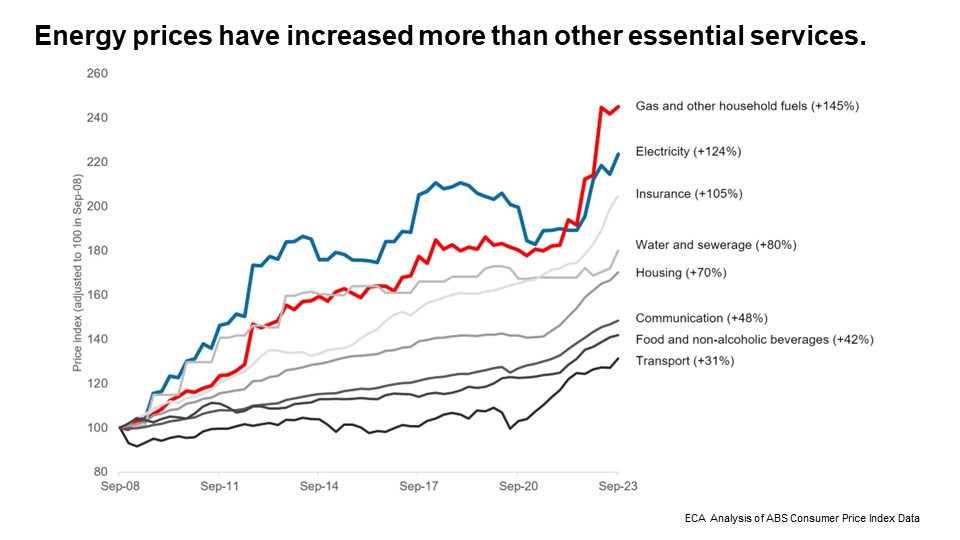From the CEO
One of the many things that makes ECA unique is the way we have listened to how Australians feel about the energy that powers their lives. For a decade we have regularly asked thousands of people a year to let us know what interests, worries, and exasperates them. Among recent trends, there are a couple I wanted to tell you about in case they worry you the same way they worry me.
1. A life without energy
We’ve all seen the double-whammy of higher energy prices – far outstripping CPI – and higher cost of living (see graph below). Worrying about prices affects everyone: 59% of households tell us they think energy might be unaffordable within three years but, importantly, many more (77%) also say it will be unaffordable for others (June 23 ECSS). What this tells me is that a significant majority of the population are thinking outside their own walls and wondering how they feel about a system that limits an essential service to exposed people due to price.

2. Information vacuums create misinformation volcanoes
Our recent survey of 2500 consumers showed that 48% – wait for it – have no memory of hearing, seeing or reading anything at all in the last year that would help them reduce bills or manage usage. Of the other 52%, what they mostly remembered was a retailer ad from the telly. (For those of you old enough to know what I’m talking about, the ink isn’t getting into the chalk.) While this is remarkable, try this one for extraordinary: 35% of consumers who believe they have received very clear communications think their bill will go down in future thanks to renewables – but that drops to only 2% of those who believe they have received unclear communications (June 23 ECSS). As obvious as it is to say, concern and confusion thrive in vacuum.
So, consumers don’t know where to go, get confused by what they find, and increasingly don’t trust what they see.
It seems to me that governments, market bodies and industry have got a big problem looming. There is an armada of energy policy bearing down on consumers over the next few years – think CER integration, smart meters, two-way grid/tariffs, electrification, demand management, energy audits/retrofits, reliability measures, EVs and more. Frankly, consumer buy-in for just about all of these is already baked into the business case but it is pretty clear the connective tissue between policy intent and consumer behaviour is too thin to succeed.
But there is a way forward.
We believe strongly that two additions to the mix would very considerably lift the odds of a successful transition and I ask you to add your voice to ours if you agree:
- Australians lack a master narrative around the transition. A narrative would provide the organising principle and motivation people need to make the right decisions for themselves and their families. (It would also go a considerable distance in filling a void increasingly attracting misinformation.) Think Slip-Slop-Slap.
- Australians need a one-stop-shop to provide essential information, advice and support to households and businesses. A pamphlet in a bill or a website only the faithful will find simply won’t cut it. What we need is a consumer-centred information hub that will provide guidance on all the topics I listed above and more. It can be – must be – the critical link in the chain that connects the entire transition back to people and their lives and decisions. There are dozens of one-stop-shops around the world. We want one here.
Which, as it happens, leads me to my shameless plug! Our upcoming Foresighting Forum (14-15 February) includes an in-person keynote from Michael Colgrove of the Energy Trust of Oregon, a one-stop-shop that has supported consumers for 20 years, saving them billions of dollars on their energy bills in the process. Even some of that would go a long way to keeping us all connected, in every possible way.
Until next time,
Brendan French

